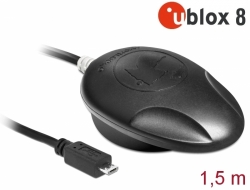Navilock NL-8001U Micro USB 2.0 Multi GNSS Receiver u-blox 8 1.5 m
Description
The USB 2.0 Multi GNSS Receiver based on u-blox 8 chipset has a built-in antenna for high sensitivity. You can use this GNSS Receiver with a mobile device and a suitable routing software for navigation.
Specification
• Connector: Micro USB 2.0 type B male
• u-blox 8 UBX-M8030-KT chipset
• Frequency:
GPS: L1, 1575.4200 MHz
GLONASS: L1, 1602 (k x 0,5625) MHz
BEIDOU COMPASS: B1, 1561.0980 MHz
GALILEO E1, 1575.4200 MHz
QZSS L1, 1575.4200 MHz
• Accepts the signals of up to 72 satellites at the same time
• Supports AssistNow online/offline,
SBAS (WAAS, EGNOS, QZSS and MSAS)
• Supports NMEA 0183 protocols: GGA, GSA, GSV, RMC, VTG
• USB specification 2.0
• Auto Baud Rate up to 115200 bps
• Update rate:
single GNSS: 18 Hz (e.g. GPS solo)
multi GNSS: 10 Hz (e.g. GPS+GLONASS)
• Sensibility max. –167 dBm
• IPX6 protection class
• Magnetic, non-slip on the bottom
• LED-indicator for GPS-status
• Operating temperature: -20 °C ~ 60 °C
• Power supply: 5 Volt
• Current consumption: max. 45 mA
• Cold start in ca. 26 seconds
• Hot start in ca. 1 second
• Positioning accuracy: 2.5 m CEP (Circular Error Probable) and
2 m CEP with SBAS
• Cable length: ca. 1.5 m
• Dimensions (LxWxH): ca. 65 x 45 x 22 mm
System requirements
- Windows Vista/7/8/8.1/10, Linux Kernel 2.6
- A free Micro USB-B female port
- For devices with OTG function and optional OTG adapter: Windows 10
Package content
- USB 2.0 receiver
- Driver CD
- User manual on CD ROM
Package
- Box
The new GNSS system requires the version 4.1 of the NMEA 0183 protocol. The evaluation software uCenter displays the Galileo satellites.
Please notice the instruction for this update.







